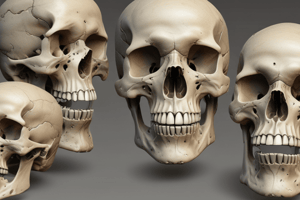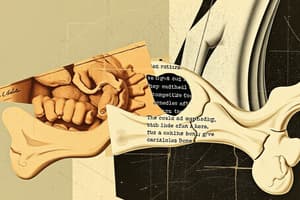Podcast
Questions and Answers
What is the first major step in endochondral ossification?
What is the first major step in endochondral ossification?
- Calcification of the cartilage matrix
- Development of a hollow bone cylinder
- Formation of the epiphyseal plate
- Appearance of the primary center of ossification (correct)
At what location does endochondral ossification primarily take place?
At what location does endochondral ossification primarily take place?
- Within trabecular bone
- Within hyaline cartilage (correct)
- Around the periosteum
- At the articular surface of the bone
What happens to the cartilage in the process of endochondral ossification?
What happens to the cartilage in the process of endochondral ossification?
- It grows indefinitely
- It undergoes degeneration and cell death (correct)
- It transforms directly into bone
- It remains unchanged throughout the process
Which zone in the epiphyseal plate is characterized by the chondrocytes increasing in size?
Which zone in the epiphyseal plate is characterized by the chondrocytes increasing in size?
What is the final stage of endochondral ossification that occurs postnatally?
What is the final stage of endochondral ossification that occurs postnatally?
What distinguishes compact bone from cancellous bone in terms of structure?
What distinguishes compact bone from cancellous bone in terms of structure?
Which of the following statements about intramembranous ossification is correct?
Which of the following statements about intramembranous ossification is correct?
Which parts of the bone contain cancellous bone?
Which parts of the bone contain cancellous bone?
What is a notable characteristic of cancellous bone compared to compact bone?
What is a notable characteristic of cancellous bone compared to compact bone?
What occurs during the calcification process in intramembranous ossification?
What occurs during the calcification process in intramembranous ossification?
Flashcards
Compact Bone
Compact Bone
Dense bone tissue, found in the shaft of long bones and outer parts of other bones, composed of tightly packed osteons.
Cancellous Bone
Cancellous Bone
Spongy bone tissue, found in the center of flat bones, ends of long bones, and irregular bones; made of trabeculae separated by marrow spaces.
Intramembranous Ossification
Intramembranous Ossification
Bone formation where bone forms directly within a mesenchymal membrane. Common in flat bones.
Endochondral Ossification
Endochondral Ossification
Signup and view all the flashcards
Osteons (Haversian Systems)
Osteons (Haversian Systems)
Signup and view all the flashcards
Primary Center of Ossification
Primary Center of Ossification
Signup and view all the flashcards
Epiphyseal Plate
Epiphyseal Plate
Signup and view all the flashcards
Bone Growth in Length
Bone Growth in Length
Signup and view all the flashcards
Calcified Cartilage Matrix
Calcified Cartilage Matrix
Signup and view all the flashcards
Study Notes
Bone Types
- Bone is organized into two forms: compact and cancellous bone.
Compact Bone
-
Sites:
- Shaft of long bones
- Outer part of short and flat bones
- Outer part of epiphysis
-
Structure:
- Covered by periosteum and lined with endosteum
- Contains osteons (Haversian systems)
- Haversian systems are composed of a Haversian canal surrounded by concentric lamellae, with interstitial lamellae between them
- Outer and inner circumferential lamellae are at the periosteum and endosteum, respectively
Cancellous Bone
-
Sites:
- Center of flat bones and irregular bones
- End of long bones
-
Structure:
- Composed of irregular trabeculae of bone
- Separated by bone marrow spaces
- Trabeculae consist of osteocytes and intercellular substance
- Covered with endosteum
- Lacks Haversian systems
Histogenesis of Bone
- Bone forms in two ways:
- Intramembranous ossification: direct mineralization of matrix secreted by osteoblasts. Occurs in flat bones (skull, clavicle)
- Endochondral ossification: deposition of bone matrix on preexisting cartilage matrix. Occurs in short and long bones.
Intramembranous Ossification
- Site: Most flat bones, skull, clavicle, and most cranial bones.
- Steps:
- Primary center of ossification appears in mesenchymal connective tissue.
- Mesenchymal cells differentiate into osteoprogenitor cells, then osteoblasts.
- Osteoblasts produce osteoid, which then calcifies.
- Osteoblasts become osteocytes.
- Connective tissue remains, becoming bone marrow cells within the spongy bone.
Endochondral Ossification
- Site: within a piece of hyaline cartilage, forming short and long bones.
- Steps:
- Primary center of ossification in the middle of the diaphysis.
- Bone tissue forms a collar around cartilage.
- Cartilage undergoes degeneration, forming calcified cartilage.
- Blood vessels from the periosteum invade calcified cartilage.
- Osteoblasts form spongy bone
- Secondary centers of ossification at the epiphyses (occur after birth).
- Epiphyseal plate persists, maintaining bone growth. The epiphyseal plate cartilage is eventually replaced and ossifies.
Growth in length of bone
- Before adulthood, interstitial growth of cartilage in the epiphyseal plate increases bone length.
- This process stops at around 17 to 20 years, leading to closure of the epiphyseal plate.
Bone Remodeling and Repair
- Previously discussed (likely described in previous parts of the lecture).
Zones of the Epiphyseal Plate
- Five zones, described in greater detail in the lecture.
Studying That Suits You
Use AI to generate personalized quizzes and flashcards to suit your learning preferences.




